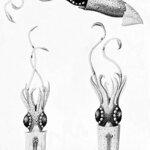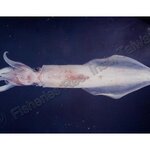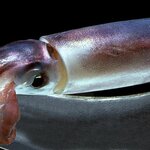Ecology & Zoology

A new paper in the African Journal of Marine Science turned me on to the genus Lycoteuthis, an open-ocean squid just bristling with light organs. According to Vecchione and Young:
Presumably they exhibit considerable bioluminescent courtship behavior which, unfortunately, has never been observed.
Oh man, talk about fireworks! Wouldn't it be incredible to be the first person to witness Lycoteuthis courtship? I may have a new goal in life.All those white pearls are photophores--light organs. Gorgeous.Major shout-out to Joe Wible, the outstanding librarian at Hopkins Marine Station, who…

Yesterday I complained that none of the articles about the New Zealand squid fishery had any quotes from fishing reps. I had only to wait 24 hours for my complaint to be answered! In a press release from the Seafood Industry Council, I learned that
The Government’s proposal to remove the tow limits imposed on squid fishing to prevent sea lion captures is based on assiduous fact-finding work driven by MAF and undertaken by a range of independent national and international science providers, says the Deepwater Group of New Zealand and the New Zealand Seafood Industry Council.
MAF is…

Today's squid news comprises four journalistic angles on the same story. See if you can figure out what it is:
Squid fishing leads to decline in sea lion numbers
Govt 'gambling with the survival' of NZ sea lions
Greens attack government fishing policy
Govt decision pushes sea lions closer to extinction - Greens
So here's the deal. Back in August, a group of kiwi scientists showed that a decline in New Zealand sea lions was largely due to their being caught and drowned in squid fishing nets. That's because sea lions love to eat squid, too, and they're fishing for this delicacy at the same…

Alternative alliterative title: Long-tailed Light-up Loliginids!
I've mentioned the two flavors of squid before: the open-ocean oegopsids and the nearshore myopsids. Most myopsids are in the family Loliginidae, which contains all your familiar calamari squid, market squid, and so on. Loliginids are traditional, uncomplicated, straightforward squid. They always look like squid--unlike oegopsids, which sometimes look like jellyfish or manta rays or piglets.
Most loliginids don't even have photophores--they leave flashy stuff like that to the oegopsids--except for one group, which I had always…
Extra-glowy squid lures are the new hotness, according to the UK's Western Morning News:
Virtually all squid jigs [fishing lures] have luminescent sections, but now available in the South West are jigs made by Japanese companies like Yo-Zuri, where intense luminescence covers the entire upper half of the jig. It may be bad news for squid . . .
Why exactly would it be bad news for the squid? Well, lights are used around the world to summon squid to their death, from glow-in-the-dark jigs to high-wattage surface lights.
Squid fishing lights are so bright and so abundant that the fleets can be…

"How big is the squid?" the fifth-graders demanded when I showed up in their classroom with a cooler on Monday.
"Humboldt squid can get up to five feet long--about as big as me," I told them. "But this one is small. It's only a couple of feet."
Fortunately, they weren't disappointed. A two-foot squid was quite exciting enough to keep the class going for two hours, pummeling me with questions as we carefully observed the outside and then the inside of the squid. The visit was part of the outreach program Squids4Kids, and the squid had been donated by sport fishermen just couple of months…

I really enjoy getting squid stories from around the world in my daily google news alert. Keeps me from getting too obsessed with the Humboldt and market squid of California. Here's the latest: ICAR scientists detect deep sea squids in Arabian Sea.
ICAR is the Indian Council of Agricultural Research, whose mandate has no doubt been expanded to include fisheries since it was named. And just who is "this largely unexploited deep sea squid which inhabits at depths ranging between 1,000 and 4,000 meters"? The article doesn't specify, but I would lay odds on Sthenoteuthis oualaniensis…

What is the point of a fishery quota if, in the years when you actually reach it, you petition the government to increase it--because there are just so many darn fish, and it would be a shame not to catch them all?
The annual quota for California market squid is so high that usually it's never reached, and therefore the fishery stays open all year. But this is the second boom year in a row, and fishers have actually caught the full 118,000 tonnes. So, time to close the fishery.
Or not.
As reported by Ed Zieralski,
Commercial squid fishermen are enjoying a banner year and have asked the…

Just got back from giving a presentation on Humboldt squid in Modesto. The audience had wonderful energy and the little kids had the BEST questions. Winners:
Third place: "What is the smallest squid?" (It's like he knew I'd just been blogging about Idiosepius!)
Second place: "Which squid has the most tentacles?" (Entertaining, of course, due to the assumption that squid have variable numbers of tentacles. And why shouldn't they?)
First place: "Do you think that maybe in the future the Humboldt squid or some other squid will take over the world?" (Winningest!)
The whole thing was taped, so…

Why do flies like beer? It's sweeter than you think. Entomologists say the flies sense glycerol, the sweet-tasting compound that yeasts make during fermentation.
The researchers examined the feeding preference of the common fruit fly for beer and other products of yeast fermentation, and found that a receptor - a protein that serves as a gatekeeper - called Gr64e is associated with neurons located in the fly's mouth is instrumental in signaling a good taste for beer.
Once a fly has settled on beer, Gr64e detects glycerol and transmits this information to the fly's neurons, which…